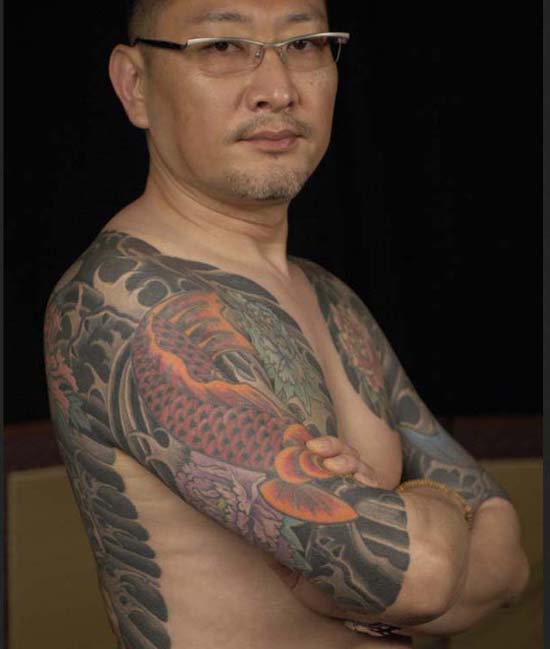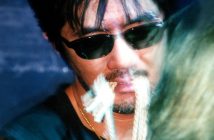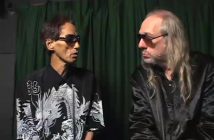Back in 2006, Osada Steve had the honor to interview Naka Akira, one of the younger Nawashi at work in Japan today. What follows is an English summary of their discussion.
Osada Steve: Please tell us how you first got interested in Shibari.
Naka Akira: They say that everyone has a turning point in their lives. I’ve had two. The first was when I was about 30 and running a porn model agency. One of our actresses was doing work for Cinemagic, a well-known SM video production company, and I happened to attend one of her video shoots. Although I thought I had absolutely no interest in SM, I suddenly realized that I had been in denial of my dominant nature all my life. Up to that point my take on SM had been like, “What? Tying up a woman and doing things to her? What kind of a person would do that?”
Something about that video shoot must have been really impressive to cause such a 180-degree turn.
You’re right. I was totally blown away by the rope work I saw there. The Nawashi doing the bondage that day was Nureki Chimuo.
And watching Nureki at work is when you decided to become a Nawashi?
No, no — I never thought I could do anything like that myself. I never thought it could ever be my work. But Nureki noticed my unusual level of interest at that shoot, and invited me to attend Kinbiken, his rope bondage study circle. I became a regular participant for the next five years.
You were much more than a participant in the Kinbiken meetings, weren’t you? Didn’t you become a formal Deshi (disciple) of Nureki?
Yes. I think I am the only person Nureki recognizes as his true Deshi.
Please tell us about that relationship. Did you receive formal instruction from Nureki?
No. It was very much a traditional Japanese master-disciple relationship in that he never actively taught me anything. Everything I learned from him I had to learn on my own, by watching. I attended the Kinbiken meetings for over a year before he even allowed me to untie one of the women he had tied up, which is of course a great way to learn how the tie is done.
You have two Deshi of your own, one of whom is sitting with us now. Do you treat them the same way?
I’ll correct them if they are doing something dangerous, but basically I conduct our relationship in the traditional manner. If the disciple wants knowledge, he has to “steal” it. The teacher doesn’t just hand it over. This is the way master-disciple relationships are conducted in all the Japanese artisan fields, whether it’s a traditional craft or fine cooking.
You are different from most of the Nawashi we’ve talked to, who generally discovered their interest in SM while still in elementary school. They grew up looking at SM magazines and were therefore exposed to the work of many different rope masters. But you came to Shibari much later, and went immediately to Nureki’s side.
That’s true. Of course I’ve looked through magazines to understand the work of other Nawashi, but in truth, Nureki is my only influence. I spent quite a bit of time searching out old magazines with his early work. He’d probably get angry if he heard me say this, but I think the work he was doing when he was in his forties is almost identical to what I do now. Since I’m still in my forties, that gives me hope that someday I might be as good as he is.
Are you developing your own style?
I am still working very much in Nureki’s style, and trying very hard to master what he does. My rope work is clean, precise and very tight, because I can’t stand loose ropes. But the true art in Nureki’s work is the Kuzushi — the small irregularities that make his bondage look real, alive and unstudied. For example, look at this photo — he doesn’t have the chest ropes lined up neatly. If an amateur did that, you’d say it was sloppy work, or a mistake. But when Nureki does that he’s got the tension perfect and it’s calculated and deliberate, part of his master plan. For example, he once told me he might do something a little irregular in order to better bring out the character of the rope for the camera, emphasizing the shadows and texture of the rope so the entire composition looks better. I don’t have that kind of command of the rope. Learning to do that will probably take me my entire life.
What else can you tell us about Nureki?
Nureki was originally a writer, and made his start in the world of SM as a contributor to Kitan Club, Japan’s first SM magazine. At that time, Kitan Club was still edited by the great Minomura Ko, a man who had tremendous influence on the development of SM in this country. Minomura had two Deshi – one was Dan Oniroku and the other was Nureki Chimuo. Dan stuck to writing and went on to become one of Japan’s most famous erotic writers, penning novels such as Hana to Hebi. Meanwhile, Nureki started doing rope bondage and became a great Nawashi. However, Nureki never stopped writing. He has written many important books and contributes regularly to SM publications even now.
Thank you for that interesting historical information. Let’s get back to you. How did you turn professional?
One of the people I came to know through the Kinbiken meetings was the president of Cinemagic, Yokobatake Kunihiko. He had been observing me at the Kinbiken meetings, and I think he spoke to Nureki about me. In any case, he offered me the opportunity to do the rope work for a video, but on one condition — that I also appear on camera. I had no acting experience whatsoever and initially refused, but he convinced me to give it a try. I think he wanted me on camera in part because I have extensive tattoos, and he wanted them in the film.
Please tell us about your tattoos. They’re quite impressive.
I was interested in tattoos from a very young age, but I knew my father wouldn’t approve and I didn’t want to offend him. But after he died, when I was 30, I went to see Horitoku, one of the top tattoo artists in Japan. He agreed to work on me, and it took a year and a half of weekly visits to complete the tattoo that completely covers my back and shoulders. It’s a famous scene from a Japanese legend, of a hero battling a carp. It’s called Oniwakamaru no Koi Taiji.
So you got your break in a Cinemagic video. That was about ten years ago, right? And what kind of work are you doing now?
I work almost exclusively in audio-visual, making 200 to 300 videos and DVDs a year. I am actively filming about half of every month. I’ve done almost no magazine work, and I never used to give life performances until very recently.
What made you become interested in starting to do shows?
Part of it was that I wanted to reach a new audience, and part of it was to challenge myself by doing a different kind of work. From the beginning, I had very specific ideas about what kind of show I wanted to do. I knew I didn’t want to do the sort of tough-guy posturing where the guy pulls the woman out on stage on a leash. When I bring my model out, I escort her, like a gentleman. And I knew I didn’t want to do fast, acrobatic rope work. Instead, I work slowly and with feeling, and try to convey all the love and emotion that passes between a man and a woman when he’s tying her up. I don’t do any other kind of SM play in my shows, like using whips or candles, because I want to use the time showing what can be done with just rope.
I’ve noticed that you use only traditional materials in your bondage.
That’s correct. I don’t use carabiners, hooks or metal of any kind. When I’m doing suspension, I use only bamboo rods or rope contraptions to attach the suspension lines.
I use Asanawa [jute rope]in 7-meter lengths. If I’m tying over clothing I use 6-mm rope, but on bare skin I’m more likely to use 4-mm rope, particularly when I’m tying legs or doing intricate ties.
If someone wanted to study your style, what would be the best way to do this?
I’d recommend looking at my Nawa-etsu [Rope Joy] series from Art Video. These productions are devoted completely to rope bondage and don’t have the distraction of other kinds of SM play. Because they are pitched to a very specific market of people who are really interested in Shibari, the Nawa-etsu series all show the rope work in great detail. It’s a small market, but the fact that we’ve been able to make six films in this series so far must mean that we are satisfying that market’s needs.
You said earlier that you’ve had two turning points in your life. What was the other?
The other was last year, when I suffered a severe heart attack and very nearly died. I spent a month in the hospital and many months after that recuperating. Facing death like that made me reevaluate everything I was doing, and helped me focus on the things that are most important to me, first and foremost of which is my family. It also helped me focus on my work, and my rope technique got much better.
Where would you like to be in ten years?
At the top. I’d like to be the best Nawashi in the world.
Is there someone you’d really like to work with? What is your dream collaboration?
For some time now, I’ve thought I’d like to a rope bondage show to live violin music. So my dream collaboration would be with violinist Kawaii Ikuko. She is a professional and very famous, so I’m sure it’s totally out of the question that she’d ever collaborate with me. But her face when she is playing the violin is exactly like the face of a woman being tied up. That’s why I like her so much.
(English summary by Alice Liddell)
[jalbum_iframe_album:https://tokyobound.com/blog/gallery/Naka%20Akira/,100%,600px]





7 Comments
Thanks a lot for another interesting interview. These insights into the japanese scene are really fascinating.
Wow…to do a rope bondage show alongside live violin music (and played by Ikuko Kawaii) will be a very intense emotional experience. I hope my luck takes me to Japan when something like that happens.
This interview is very interesting, it is always exciting to see how someone goes to Nawashi from any other path of life. I always wonder about the kind of people you must meet, the influences you are exposed to, and the chance (or otherwise) events that make it happen. One of the main ingredients, I believe, is to live or at least being able to interact with the bdsm scene often and know your people. As with other things in life, I wonder how many of today’s rope artists started to do this professionally because at some point they knew someone, or someone watched their work or their enthusiasm, as opposed to them trying to force their way into the circle of rope. As a Taoist might say, you probably just let the circle grab you as you walk by…
Great Interview, Its really great you brought out this interview for us to read. Thanks
M
Got a link for the Nawa-etsu series?
Wonderful interview. Thank you : )
Always a pleasure to get this insight .. thank you very much for it!
Pingback: 奈加あきら – 縛.生